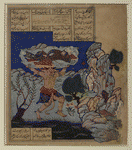| PREVIOUS | NEXT | NEW SEARCH |
Selections of Arabic, Persian, and Ottoman Calligraphy

|
The Div Akvan throws Rustam into the sea
AUTHOR/CREATOR
Calligrapher: unknown
CREATED/PUBLISHED
16th-17th centuries
NOTES
Dimensions of painting: 19 (w) x 21 (h) cm
Dimensions of Written Surface: 13.9 (w) x 24.8 (h) cm
Script: nasta'liq
This painting represents an episode described in Firdawsi's "Shahnamah" (The Book of Kings), the epic story of ancient kings and heroes of Persia composed by the renowned author during the first decades of the 11th century. The text on the fragments recto and verso describes the painting. King Khusraw summons Rustam to help him stop a demon (div) disguised as a wild ass that is ravaging of the royal herds. After three days of unsuccessful battle, the hero falls asleep in the grass. Thereupon, the Div Akvan casts aside his disguise, resumes his demonic form, rushes towards Rustam, and digs up the ground around the hero. He gives Rustam the choice of being thrown against the mountains, to be eaten by lions and onagers, or cast into the sea, where he would drown to his death. Knowing that the enemy would do the exact opposite and realizing that, if cast to the sea, he would have a chance to swim to survival, he asked to be thrown against the mountains. Rustam is cast to the sea, swims back to the shore, and returns to defeat the demon in combat.
The painting shows the precise moment when the Div Akvan pauses before deciding to hurl Rustam into the waters. The demon stands tall, his arms clutching to the ground on which a still sleeping Rustam lays, as his gold bell bangles clang loudly. A posteriori labels added to the right of Rustam's head and at the demon's waist identify the actors Rustam and Div Akvan. On the right side of the composition, rocky mountains and two threatening tigers are depicted, while, at the bottom of the painting, the sea appears inhabited by a variety of fish. Immediately above the painting, the chapter heading executed in gold ink identifies the scene and its corresponding text.
The painting's style and composition are typical of illustrated manuscripts of Firdawsi's "Shahnamah" produced during the Safavid period in Iran. The rocky outcrop, loosely painted in light blue, pink, and yellow washes, sometimes creates formations that hint at facial features. The layout of the text and the script (nasta'liq) as visible on the painting's verso (see 1-88-154.118 V) also characterize 16th-century Persian manuscripts.
Unfortunately, the lower right corner of the painting has suffered damage and thus a small portion of the painting is lost to us today.
SUBJECT
Arabic script calligraphy
Illuminated Islamic manuscripts
Islamic calligraphy
Islamic manuscripts
Nasta'liq
Arabic calligraphy
MEDIUM
20.6 (w) x 26.6 (h) cm
CALL NUMBER
1-88-154.118
REPOSITORY
Library of Congress, African and Middle Eastern Division, Washington, D.C. 20540
DIGITAL ID
ascs 196
http://hdl.loc.gov/loc.amed/ascs.196
| PREVIOUS | NEXT | NEW SEARCH |